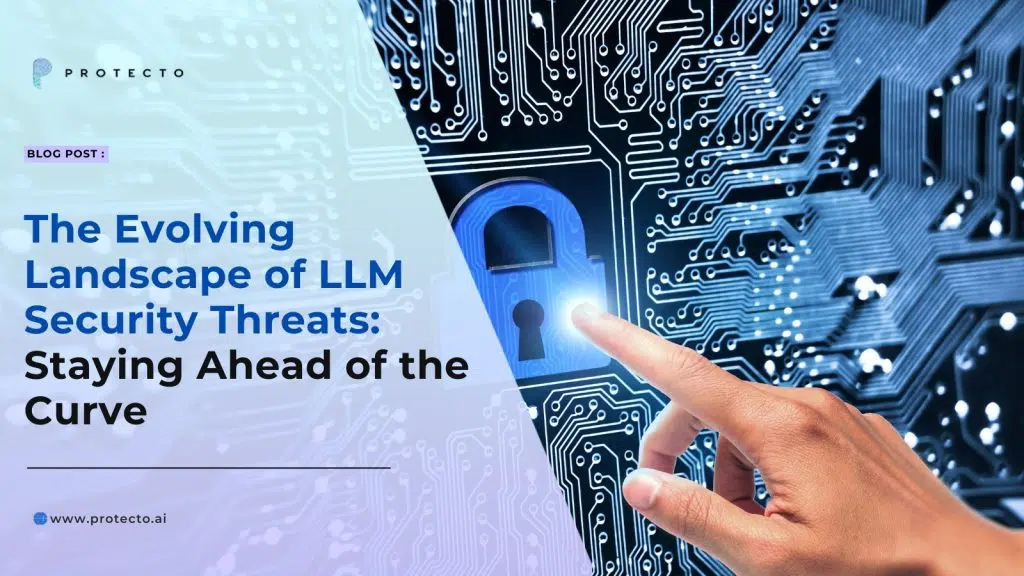The rapid adoption of large language models (LLMs) has significantly transformed various industries, offering powerful AI-driven capabilities for multiple use cases. However, as organizations integrate LLMs into their workflows, the risks associated with LLM security have also intensified. From LLM security threats to LLM safety concerns, businesses must proactively address the growing vulnerabilities that threaten these advanced AI systems.
Here, we will delve into the evolving landscape of LLM security threats, exploring the various attack vectors and vulnerabilities that organizations must grapple with. We will also discuss the development of proactive security strategies, emerging security frameworks and standards, and the future outlook for safeguarding LLM-powered applications in these ever-changing challenges.
Understanding the Emerging LLM Security Landscape

Model Manipulation and Adversarial Attacks
One of the most pressing LLM security concerns is the possibility of model manipulation. Cybercriminals can introduce backdoor attacks, data poisoning, or adversarial inputs to alter the model’s behavior. This can lead to biased, inaccurate, or even harmful responses, undermining the integrity of LLM-powered applications.
These model-based attacks can generate biased, inappropriate, or even harmful content, undermining the reliability and trustworthiness of the LLM-powered applications. Defending against such attacks requires a deep understanding of the model architectures, training processes, and potential vulnerabilities and developing robust input validation and model monitoring mechanisms.
Malicious Content Generation
The vast capabilities of LLMs allow them to generate human-like content at scale, but adversaries can exploit this for nefarious purposes, such as misinformation, hate speech, or harmful code. Without LLM security monitoring and testing, bad actors can manipulate these models to generate deceptive or unethical content.
Adversaries may leverage LLM-powered tools to automate the production of large volumes of harmful content, which can then be disseminated widely to cause damage or influence public opinion.
Mitigating the risks of malicious content generation requires a multifaceted approach, including advanced content moderation techniques, sentiment analysis, and content filtering mechanisms tailored to the unique characteristics of LLM-generated output.
Data Theft and Privacy Breaches
Organizations utilizing LLMs often process vast amounts of sensitive data. Poor LLM security architecture can leave critical business and personal data exposed, making it an attractive target for cybercriminals. LLM data protection measures such as encryption, access control, and secure storage are necessary to prevent unauthorized access and data leaks.
LLM-powered applications often handle sensitive user data, such as personal information, communication transcripts, or proprietary business data used for model training. This data can be a valuable target for malicious actors, who may endeavor to exploit vulnerabilities in the application’s architecture or gain unauthorized access to the LLM components to steal or compromise this information.
Safeguarding against data theft and privacy breaches in the LLM ecosystem requires robust data protection measures, including advanced encryption techniques, secure data storage and processing, and the implementation of strict access controls and identity management protocols.
System Vulnerabilities and Exploits
Since LLM-powered applications rely on APIs, cloud services, and integrations, LLM security issues can emerge from misconfigured access points or software bugs. Attackers may exploit these weaknesses to gain unauthorized access or disrupt essential operations.
These vulnerabilities can range from insecure API endpoints and misconfigured cloud resources to software bugs and design flaws that can be leveraged to gain unauthorized access or disrupt the system’s operation.
Identifying and addressing these vulnerabilities requires a comprehensive security assessment of the entire LLM-powered application ecosystem. This assessment must also include implementing hardy security criteria, such as secure coding practices, vulnerability management, and ongoing security monitoring and testing.
Disinformation and Influence Campaigns
LLMs can be misused to automate large-scale disinformation campaigns, manipulating public opinion and spreading propaganda. Organizations must deploy LLM security solutions to detect and counteract misleading or harmful AI-generated content.
The ability of LLMs to generate human-like text has also raised concerns about their potential use in large-scale disinformation and influence campaigns. Adversaries may leverage LLM-powered tools to automate the creation and dissemination of fake news, propaganda, and other misleading content, as well as manipulate public opinion and sow discord.
Combating LLM-powered disinformation and influence campaigns requires a collaborative effort involving researchers, policymakers, and technology providers. Developing effective detection and mitigation strategies, such as content authenticity verification, source attribution, and coordinated response mechanisms, can help counter the threat of LLM-driven manipulation and deception.
Proactive Security Strategies for LLM-Powered Applications

Comprehensive Risk Assessment
A thorough risk assessment helps identify vulnerabilities in LLM security architecture and pinpoint weak links in data flows, access controls, and integration points. This process should involve analyzing the application’s architecture, data flows, access controls, and integration points and considering the unique security challenges associated with LLMs.
By prioritizing security measures based on the assessed risks, organizations can allocate resources and implement targeted security strategies to mitigate the most critical threats, ensuring the overall resilience and security of their LLM-powered solutions.
Implement LLM Security Monitoring and Testing
Continuous LLM security monitoring and testing are crucial to detecting suspicious activity. Logging system events, tracking API usage, and leveraging machine learning-based anomaly detection can provide real-time alerts against potential security breaches.
Implementing real-time monitoring mechanisms, such as logging system events, tracking API usage, and analyzing user interactions, can help identify anomalies or suspicious activities that may indicate potential security breaches or system vulnerabilities.
Advanced anomaly detection techniques, leveraging machine learning algorithms and behavioral analysis, can further enhance the ability to identify and respond to malicious patterns or unusual activities within the LLM-powered application. By quickly detecting and addressing these anomalies, organizations can minimize the consequences of security incidents and maintain the integrity and trustworthiness of their LLM-powered systems.
Secure Model Updating and Retraining
Regular updates and fine-tuning are essential for mitigating new LLM security threats. Secure update mechanisms, including cryptographic verification and strict version control, prevent unauthorized model modifications and reduce attack risks. Additionally, continuously evaluating the updated models can help validate their security and performance before deployment.
Use Synthetic Data Generation for Security Testing
Organizations can leverage synthetic data to test LLM security solutions against adversarial attacks. By simulating threats, security teams can better assess vulnerabilities and refine defense mechanisms.
By generating realistic yet synthetic data samples that mimic real-world threats, such as adversarial inputs or malicious content, security teams can assess the application’s ability to detect, mitigate, and recover from such attacks. This approach can help identify vulnerabilities, evaluate the effectiveness of security controls, and inform the continuous improvement of the application’s security posture.
A tool like Protecto, with its advanced features, can help protect PII in LLM use cases by leveraging synthetic data, data masking, and other techniques.
Collaborative Threat Intelligence Sharing
Cyber threats evolve rapidly, making collaboration critical. Organizations should participate in LLM security framework initiatives, engage in industry-wide knowledge sharing, and implement shared mitigation strategies to stay ahead of emerging threats.
By fostering knowledge-sharing initiatives, such as security research forums, bug bounty programs, and industry-wide working groups, organizations can stay informed about emerging threats, vulnerabilities, and attack vectors in the LLM ecosystem. This collaborative approach can help organizations proactively address security challenges and contribute to the development of more secure and trustworthy LLM-powered applications.
Enhance LLM Data Protection
Strong LLM data protection practices should be in place, including robust encryption, role-based access control, and compliance with data privacy regulations like GDPR and HIPAA. Tools such as Protecto offer solutions like data masking and synthetic data generation to safeguard sensitive information in LLM-powered applications.
Emerging Security Frameworks and Standards for LLMs
Development of LLM-Specific Security Guidelines
As LLM security concerns grow, standardizing security practices is becoming increasingly important. Establishing security frameworks tailored to LLMs, including secure API design, robust access controls, and transparent data usage policies, will help mitigate risks.
As the LLM landscape continues to evolve, there is a growing need for industry-wide security standards and best practices to guide the development and deployment of these powerful AI systems. Establishing LLM-specific security guidelines can help organizations and LLM providers align their security measures, ensure consistent security practices, and promote transparency and accountability.
By encouraging the adoption of these standards, the LLM ecosystem can collectively enhance the overall security and resilience of LLM-powered applications.
Secure LLM Model Licensing and Deployment
Organizations should adopt secure distribution channels, cryptographic signatures, and trusted model licensing mechanisms to prevent compromised models from being deployed in production systems.
Also, establishing guidelines for secure model deployment, such as container and infrastructure configurations, can further strengthen the security posture of LLM-powered systems and mitigate the risks of supply chain attacks or unauthorized model access.
Regulatory Frameworks and Compliance Considerations
Compliance with evolving regulations is essential for ensuring LLM safety and trustworthiness. Adhering to established security protocols in sensitive industries like healthcare, finance, and government will help organizations mitigate legal and reputational risks.
As the use of LLM-powered applications continues to grow, particularly in sensitive domains such as finance, healthcare, and government, regulatory frameworks and compliance requirements will play an increasingly crucial part in shaping the security landscape.
Addressing evolving data privacy and security regulations, such as the General Data Protection Regulation (GDPR) or the Health Insurance Portability and Accountability Act (HIPAA), will be crucial for organizations operating LLM-powered applications. Aligning security measures with these compliance requirements can help protect sensitive user data and maintain the trust of stakeholders and customers.
Future Outlook for LLM Security
As LLM technology continues to evolve, so will the complexity of LLM security threats. Organizations must adopt a proactive, multi-layered approach by integrating LLM security tools, conducting rigorous security assessments, and staying aligned with regulatory requirements. Collaboration between AI researchers, cybersecurity experts, and policymakers will be crucial in building a more secure LLM ecosystem.
By implementing these LLM security best practices, businesses can minimize vulnerabilities and ensure the safe and ethical deployment of LLM-powered solutions.
Additionally, advocating for increased transparency and accountability in the LLM ecosystem through initiatives such as open-source model development, security audits, and third-party certifications can help build trust and confidence in the security of these robust AI systems.




